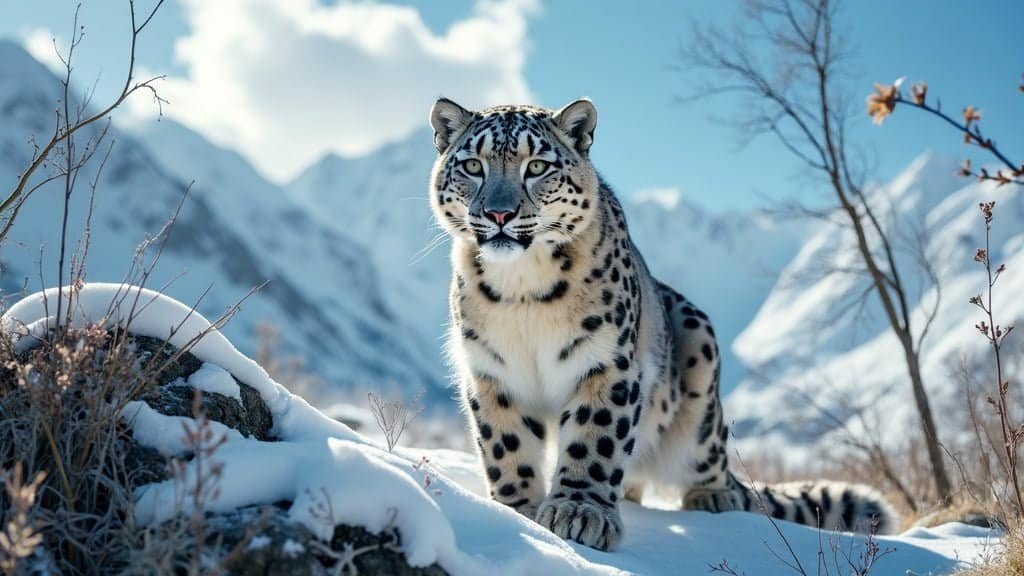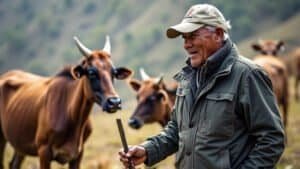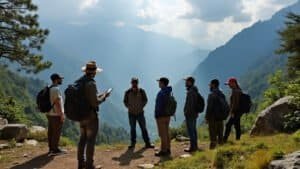Introduction
Raising public awareness about snow leopards is crucial for their survival as they face threats from habitat loss, poaching, and climate change. This article explores the most effective strategies for educating diverse audiences about these elusive big cats
From integrating snow leopards into school curricula to leveraging social media and community involvement, we’ll examine practical approaches to boosting awareness and driving conservation efforts
Additionally, we’ll delve into successful campaigns, digital resources, and the challenges of engaging the public in snow leopard conservation. Whether you’re an educator, conservationist, or wildlife enthusiast, these strategies will help you make a significant impact
How Schools Can Teach Students About Snow Leopards
Education in schools is a powerful tool for raising awareness about snow leopards, their ecological importance, and the conservation challenges they face. Schools have the unique opportunity to shape young minds and instill a lifelong passion for wildlife conservation
By integrating snow leopard education into the curriculum, using interactive tools, and offering hands-on learning experiences, schools can make a significant impact on students’ understanding and commitment to protecting these majestic creatures
Integrating Snow Leopards into the Curriculum
One of the most effective ways to educate students about snow leopards is by embedding their study into existing curricula across various subjects. In science classes, for example, snow leopards can be introduced when discussing ecosystems, biodiversity, and conservation biology
Lessons can explore the snow leopard’s role as an apex predator in the mountainous regions of Central and South Asia, emphasizing its influence on maintaining the balance within its ecosystem. Teachers can develop modules that cover topics such as the snow leopard’s diet, habitat, and the factors contributing to its endangered status
In geography classes, students can learn about the regions where snow leopards are found, such as the Himalayas, and how these landscapes are affected by climate change and human encroachment. History and social studies classes can focus on the cultural significance of snow leopards to the indigenous peoples of these regions and how traditional practices intersect with modern conservation efforts
Incorporating snow leopards into literature and art classes can also be impactful. Students could read stories or watch documentaries that highlight snow leopards, followed by discussions or creative projects where they express their learning through essays, paintings, or digital media. Such multidisciplinary approaches ensure that students not only learn about snow leopards but also appreciate the broader implications of conservation
Using Interactive Tools and Games for Engagement
Interactive tools and educational games can greatly enhance students’ engagement and understanding of snow leopards. Digital tools, such as interactive maps and virtual field trips, allow students to explore the snow leopard’s habitat without leaving the classroom
For instance, tools like Google Earth can be used to take virtual tours of the rugged terrains where snow leopards live, providing a visual and immersive learning experience
Educational games that simulate the life of a snow leopard can also be effective. These games can teach students about the challenges snow leopards face, such as finding food and avoiding poachers, while also highlighting the importance of conservation efforts
Programs like “EcoKids” or “Wildlife Warriors” often have modules focused on endangered species, where students can learn about snow leopards through quizzes, puzzles, and interactive storytelling
Moreover, incorporating augmented reality (AR) or virtual reality (VR) can take engagement to the next level. AR applications could allow students to see a snow leopard “appear” in their classroom, providing a close-up view of the animal in a safe environment
VR experiences could simulate a day in the life of a snow leopard, where students experience the challenges of survival in the wild, thus deepening their empathy and understanding
Field Trips and Hands-On Learning Experiences
Field trips and hands-on experiences are invaluable for deepening students’ connection to snow leopards and the natural world. Visits to zoos or wildlife sanctuaries that have snow leopards can offer students a rare chance to see these animals up close
Zoos like the Bronx Zoo or the San Diego Zoo, which have snow leopards as part of their conservation programs, often provide educational tours that include talks by wildlife experts, who explain the importance of snow leopard conservation and the specific efforts being made to protect them
In addition to zoo visits, schools can organize trips to natural history museums or conservation centers where students can participate in workshops or interactive exhibits focused on snow leopards
These experiences can be complemented by guest lectures from conservationists or researchers who work directly with snow leopards, providing students with firsthand insights into the challenges and successes of conservation work
Schools can also implement citizen science projects where students contribute to snow leopard research. For example, they could participate in tracking snow leopard sightings using data from camera traps, helping researchers identify movement patterns and population sizes
Such projects not only teach students about snow leopards but also involve them directly in conservation efforts, making their education more relevant and impactful
Incorporating these methods into school education not only raises awareness about snow leopards but also helps cultivate a generation of informed and passionate conservationists who are better equipped to tackle the environmental challenges of the future
Social Media Campaigns and Their Role in Snow Leopard Education
Social media has become a critical tool in raising awareness and educating the public about environmental issues, including the conservation of snow leopards
With the ability to reach millions of people across the globe instantly, social media platforms offer unique opportunities to engage, inform, and mobilize individuals in support of snow leopard conservation
By creating viral campaigns, engaging influencers, and utilizing targeted educational content, conservationists can significantly amplify their message and foster a broader public understanding of the plight of snow leopards
Creating Viral Campaigns for Maximum Impact
One of the most effective ways to raise awareness about snow leopards through social media is by creating viral campaigns. A successful viral campaign can reach a large audience quickly and generate widespread attention
To achieve this, the campaign must be compelling, emotionally resonant, and easy to share. For instance, a campaign could feature powerful imagery or video content that showcases the beauty and vulnerability of snow leopards, paired with a simple but memorable hashtag like #SaveTheSnowLeopard
Storytelling plays a crucial role in making a campaign go viral. Narratives that focus on individual snow leopards, their survival stories, or the efforts of local communities to protect them can create a deep emotional connection with the audience. When people feel emotionally invested, they are more likely to share the content with their networks, further expanding its reach
For example, a video campaign that follows the journey of a snow leopard cub from birth to maturity, highlighting the challenges it faces, can be both educational and moving, encouraging viewers to take action
To maximize the impact, campaigns should be timed around significant dates, such as International Snow Leopard Day (October 23), when public interest in the species is naturally heightened. Leveraging these moments ensures that the campaign benefits from increased visibility and participation
Engaging Influencers and Celebrities for Awareness
Influencers and celebrities can play a significant role in amplifying the message of snow leopard conservation on social media. With their large followings, these public figures have the power to bring attention to causes that may otherwise go unnoticed
Partnering with influencers who are passionate about wildlife and conservation can help reach new audiences who may not be familiar with snow leopards or the threats they face
For example, celebrities like Leonardo DiCaprio, known for his environmental activism, have previously used their platforms to raise awareness about endangered species. By sharing content related to snow leopards, such as photos, videos, or informative posts, influencers can drive significant engagement and increase the reach of conservation messages
The involvement of a well-known figure can also lend credibility to the cause, making it more likely that followers will take the message seriously and share it further
In addition to celebrities, micro-influencers—individuals with smaller but highly engaged followings—can also be valuable partners. These influencers often have a strong connection with their audience, and their endorsement can lead to higher engagement rates
Collaborating with wildlife photographers, environmental bloggers, or nature enthusiasts who are already advocating for conservation can help spread the message to niche audiences who are likely to be more receptive to the cause
Utilizing Platforms for Targeted Educational Content
Different social media platforms offer various features that can be leveraged to create and share targeted educational content about snow leopards. Each platform has its own strengths, and understanding how to use them effectively is key to reaching the desired audience
On Instagram, visual content reigns supreme. High-quality photos and videos of snow leopards in their natural habitats can captivate viewers and drive engagement
Instagram Stories and Reels can be used to share quick facts, updates on conservation projects, or short clips of snow leopards, while longer posts can dive deeper into educational content. Instagram’s carousel feature, for example, allows users to swipe through a series of images or infographics, making it an ideal format for sharing detailed information in a visually appealing way
Twitter, with its fast-paced and concise format, is perfect for sharing updates, news, and quick facts about snow leopards. Conservation organizations can use Twitter to join trending conversations, participate in relevant hashtags, and engage directly with their followers through Q&A sessions or live tweets during documentaries or events focused on snow leopards
Facebook, with its broader user demographic, is ideal for more in-depth content. Posts can include detailed articles, educational videos, and links to conservation resources. Facebook Groups dedicated to wildlife enthusiasts or conservation can also be a space for deeper engagement, where users can share information, ask questions, and participate in discussions about snow leopards
YouTube, as a video-centric platform, is perfect for longer educational content. Documentaries, interviews with conservation experts, and behind-the-scenes looks at conservation efforts can be uploaded and shared widely. YouTube’s search functionality also makes it easier for users interested in specific topics, like snow leopards, to discover relevant content
Moreover, TikTok has emerged as a platform with massive potential for reaching younger audiences. Short, engaging videos that highlight fun facts, conservation challenges, or even show a day in the life of a snow leopard can quickly go viral. Given the platform’s algorithm that favors content with high engagement, creating educational but entertaining videos can help reach a vast audience
By strategically utilizing these platforms, conservation organizations can create a comprehensive social media presence that educates diverse audiences about snow leopards and drives meaningful action towards their protection
Community Involvement in Snow Leopard Conservation
Community involvement is a cornerstone of successful conservation efforts, particularly when it comes to protecting elusive species like snow leopards. By engaging local communities that share their habitats with snow leopards, conservationists can foster sustainable practices and ensure long-term protection of these big cats
Effective strategies include encouraging local conservation efforts, implementing community-based educational programs, and partnering with local businesses and leaders
Encouraging Local Conservation Efforts
Local communities play a critical role in snow leopard conservation, as they are often the first to witness the impacts of human-wildlife conflicts and environmental changes in snow leopard habitats. Encouraging and supporting these communities to engage in conservation efforts is essential for protecting snow leopards
One approach is to involve community members in anti-poaching patrols and monitoring activities. Programs like the Snow Leopard Trust’s “Snow Leopard Enterprises” provide incentives for local people to protect snow leopards by offering them alternative income sources, such as selling handicrafts
In return, communities agree to avoid killing snow leopards, even in cases of livestock predation. This approach not only helps to protect snow leopards but also improves the economic well-being of the communities involved
Community members can also participate in citizen science projects, such as monitoring snow leopard populations using camera traps. By training locals to use these devices and interpret the data, conservation organizations empower them to take an active role in protecting their local wildlife
This hands-on involvement fosters a sense of ownership and responsibility for the conservation of snow leopards, which is crucial for the success of long-term efforts
In areas where snow leopards pose a threat to livestock, compensation programs can be implemented to mitigate human-wildlife conflicts. These programs provide financial compensation to herders who lose animals to snow leopard predation, reducing the incentive for retaliatory killings. Such initiatives help to build trust between conservationists and local communities, making them more willing partners in conservation efforts
Community-Based Educational Programs
Educating local communities about snow leopards and the importance of their conservation is a key strategy in fostering community support. Community-based educational programs tailored to the cultural and linguistic context of the region can be particularly effective in reaching a wide audience
These programs often include workshops, school visits, and public talks aimed at raising awareness about snow leopards, their ecological role, and the threats they face
For instance, the Snow Leopard Conservancy offers education programs that teach community members about the ecological importance of snow leopards and how their presence can be a sign of a healthy ecosystem
Cultural sensitivity is crucial in these programs. By respecting local traditions and beliefs, conservationists can better engage communities and incorporate traditional knowledge into conservation strategies. For example, in some regions, snow leopards are revered as sacred animals. Conservation programs that highlight these cultural connections can strengthen local support for snow leopard protection
Youth education is particularly important in these efforts. By involving children and young adults in conservation activities, such as nature camps or wildlife clubs, conservationists can instill a sense of responsibility and passion for snow leopard conservation in the next generation
Schools can also incorporate snow leopard education into their curricula, ensuring that students learn about the species and the importance of biodiversity from a young age
Mobile education units can be effective in reaching remote communities that may not have easy access to formal education programs. These units can travel to different villages, offering interactive lessons, films, and activities that engage both children and adults in learning about snow leopards
Partnering with Local Businesses and Leaders
Local businesses and community leaders can be powerful allies in snow leopard conservation. By partnering with these stakeholders, conservation organizations can create a broader support network and ensure that conservation efforts are economically and socially sustainable
Ecotourism is one way to involve local businesses in snow leopard conservation. By developing tourism activities centered around snow leopard watching, local businesses can benefit financially from the presence of snow leopards, providing an incentive to protect them
This approach not only supports conservation but also boosts the local economy. Successful examples include snow leopard tracking tours in Ladakh, India, where local guides lead tourists on treks to spot these elusive cats, providing income for the community and promoting wildlife conservation
Local businesses can also participate in conservation efforts by adopting sustainable practices that minimize their impact on snow leopard habitats. For instance, businesses involved in agriculture or livestock rearing can implement predator-friendly practices, such as using livestock enclosures that prevent snow leopard attacks, thereby reducing human-wildlife conflict
Community leaders, including village elders and religious figures, can help to mobilize support for snow leopard conservation
Their endorsement of conservation initiatives can lend credibility and authority to the efforts, making it easier to gain widespread community support. Leaders can also facilitate discussions between conservationists and community members, helping to address concerns and build trust
Moreover, involving local leaders in decision-making processes ensures that conservation strategies are aligned with the needs and priorities of the community. This collaborative approach increases the likelihood of successful and sustainable conservation outcomes
Community involvement is vital to the success of snow leopard conservation. By engaging local communities through conservation efforts, educational programs, and partnerships with businesses and leaders, we can build a strong foundation for the long-term protection of these magnificent animals
Effective Awareness Campaigns for Snow Leopards
Raising awareness about snow leopards is crucial to their conservation. Effective campaigns not only inform the public about the challenges facing snow leopards but also inspire action to protect them
Successful campaigns typically involve a combination of storytelling, collaboration with international NGOs, and the creation of compelling educational materials. By analyzing these strategies, conservationists can learn how to craft campaigns that resonate with diverse audiences and drive real-world impact
Analyzing Successful Global Campaigns
Looking at successful global campaigns can provide valuable insights into what works best in raising awareness about snow leopards. One such campaign is the Global Snow Leopard & Ecosystem Protection Program (GSLEP), launched in 2013
This initiative brought together 12 range countries where snow leopards are found, along with international conservation organizations, to develop a comprehensive strategy for snow leopard conservation
The GSLEP campaign succeeded by focusing on collaborative efforts at both the local and international levels. It highlighted the importance of protecting not just the snow leopard but also the ecosystems they inhabit, which are crucial for the livelihoods of millions of people
The campaign’s use of scientific data to set clear conservation goals, such as securing 20 snow leopard landscapes by 2020, provided a focused and measurable objective that resonated with stakeholders and the public alike
Another effective campaign is the World Wildlife Fund’s (WWF) “Ghost of the Mountains” campaign. This initiative used powerful imagery and storytelling to bring attention to the elusive nature of snow leopards, often referred to as the “ghost of the mountains” due to their stealthy and secretive behavior
The campaign employed a mix of traditional media, social media, and public events to reach a global audience, emphasizing the snow leopard’s plight and the urgent need for conservation action. The emotional appeal of the campaign, coupled with clear calls to action, helped generate significant public interest and support
Both campaigns demonstrate the importance of setting clear, achievable goals, using compelling narratives, and engaging a wide range of stakeholders to create impactful awareness campaigns
Collaborating with International NGOs
Collaborating with international non-governmental organizations (NGOs) is a key strategy in amplifying the reach and effectiveness of snow leopard awareness campaigns. NGOs like the Snow Leopard Trust, Panthera, and the WWF have extensive experience in wildlife conservation and can provide valuable resources, expertise, and networks to support awareness efforts
International NGOs often have the capacity to conduct large-scale campaigns that can reach audiences across multiple countries
For instance, the Snow Leopard Trust works in several of the snow leopard’s range countries, including Mongolia, India, and Kyrgyzstan, and their campaigns benefit from this broad geographic reach. By partnering with local organizations and communities, these NGOs ensure that their campaigns are culturally relevant and effective
These collaborations can also help secure funding for awareness campaigns. Many NGOs have access to grants, donor networks, and corporate partnerships that can provide the financial resources needed to run extensive campaigns. Moreover, their established credibility can make it easier to attract media attention and public support
A collaborative approach also allows for the sharing of best practices and successful strategies. For example, international NGOs often have the ability to analyze the effectiveness of various campaign tactics across different regions, providing valuable insights that can be applied to future campaigns
By working together, these organizations can pool their resources and expertise to create more powerful and far-reaching campaigns for snow leopard conservation
Creating Compelling Educational Materials
The creation of compelling educational materials is fundamental to any successful awareness campaign. These materials help to communicate the importance of snow leopard conservation in a way that is accessible and engaging to the general public
Visual content is particularly powerful in raising awareness. High-quality photographs, videos, and infographics can capture the beauty of snow leopards and the harsh environments in which they live
For instance, the Snow Leopard Trust regularly shares stunning images and videos of snow leopards on its social media platforms, often accompanied by educational captions that inform viewers about the species and the threats they face
Documentaries are another effective medium for education. Films like “Ghost of the Mountains,” produced by DisneyNature, bring the story of snow leopards to life for a global audience. By showcasing the challenges snow leopards face in their natural habitat, such as extreme weather conditions and the encroachment of human activities, these documentaries can inspire viewers to take action
Additionally, they often include information on how viewers can contribute to conservation efforts, such as through donations or supporting policy changes
Printed materials, such as brochures, posters, and educational booklets, are also important tools, particularly in regions with limited internet access. These materials can be distributed in schools, community centers, and wildlife parks to reach a broader audience
Educational booklets that include facts about snow leopards, their ecosystems, and conservation strategies can be used by teachers as part of their curriculum or by NGOs during community outreach programs
Moreover, interactive digital tools can engage younger audiences. Educational websites with interactive maps, quizzes, and games related to snow leopards can make learning fun and memorable. Apps that allow users to explore snow leopard habitats or track conservation efforts in real-time can also enhance public engagement
The key to creating effective educational materials is ensuring that they are not only informative but also emotionally engaging. By appealing to the public’s sense of wonder and responsibility, these materials can inspire individuals to become advocates for snow leopard conservation
Digital Resources and Tools for Snow Leopard Education
In the digital age, online resources and tools have become indispensable in spreading awareness and educating the public about snow leopards
These resources make it possible to reach a global audience, providing accessible, engaging, and interactive ways to learn about snow leopards and the challenges they face. From websites and online courses to virtual reality experiences and educational apps, digital platforms offer diverse opportunities for enhancing snow leopard conservation efforts
Best Websites and Online Courses
Websites dedicated to snow leopard conservation serve as comprehensive sources of information, offering everything from basic facts to in-depth research
The Snow Leopard Trust, for instance, has a well-structured website that includes detailed sections on snow leopard biology, habitat, and conservation strategies. It also features regular updates on ongoing conservation projects, allowing visitors to stay informed about current efforts to protect these animals
Panthera, another leading organization in big cat conservation, provides extensive educational content on its website, including scientific articles, interactive maps of snow leopard habitats, and case studies of successful conservation programs. Their resources are geared towards both the general public and professionals in the field, making it a valuable tool for a wide range of users
For those looking for more structured learning, online courses are available through platforms like Coursera and edX. These courses, often offered by universities or in collaboration with NGOs, cover topics such as wildlife conservation, ecology, and specific courses focused on big cat conservation
For example, a course on “Big Cats: Predators under Threat,” available on Coursera, includes modules specifically about snow leopards, their behavior, and conservation efforts
The World Wildlife Fund (WWF) also offers educational content through its website, including downloadable lesson plans for teachers, infographics, and interactive activities that can be used in classrooms or at home. These resources are particularly valuable for educators seeking to incorporate snow leopard conservation into their teaching
Virtual Reality and Immersive Experiences
Virtual reality (VR) and other immersive digital experiences offer innovative ways to engage people in snow leopard conservation
These tools can transport users to the remote, mountainous regions where snow leopards live, providing a firsthand experience of their environment and the challenges they face
One notable example is the “Snow Leopard VR Experience,” developed by the Snow Leopard Trust. This immersive experience allows users to “walk” through the snow leopard’s habitat, observe their behaviors, and learn about the threats to their survival
By simulating the experience of being in the snow leopard’s natural environment, VR can create a powerful emotional connection between the user and the animal, fostering a deeper understanding and commitment to conservation
Additionally, Google Earth offers a feature called “Voyager,” which includes guided tours of snow leopard habitats. These tours, often narrated by conservation experts, provide an interactive way for users to explore the regions where snow leopards live, learn about the local communities, and understand the conservation efforts taking place. These experiences can be particularly impactful for students and young adults, as they combine education with the thrill of exploration
Augmented reality (AR) applications also offer unique educational opportunities. Apps like WWF’s “Free Rivers” use AR to demonstrate the impact of environmental changes on ecosystems, including those inhabited by snow leopards
By interacting with these digital tools, users can visualize how actions such as deforestation or climate change can affect wildlife, helping to convey complex ecological concepts in an intuitive way
Educational Apps and Games
Educational apps and games have become popular tools for teaching younger audiences about wildlife conservation. These digital tools make learning about snow leopards fun and interactive, which can be particularly effective in capturing the attention of children and teenagers
One example is the “Wildlife Watch” app, developed by the Zoological Society of London (ZSL). This app allows users to observe animals in their natural habitats through live camera feeds. While primarily focused on various species, it includes snow leopards as part of its featured wildlife. The app also provides educational content about each species, including facts about their habitat, behavior, and conservation status
Another app, “Animal Jam,” developed in partnership with National Geographic, is an online playground for kids that combines gaming with education. Players can create avatars, explore virtual worlds, and learn about different animals, including snow leopards. The game includes educational videos, quizzes, and activities that teach players about wildlife conservation in an engaging way
For a more hands-on learning experience, the “Seek” app by iNaturalist encourages users to explore nature and document their findings
While not focused exclusively on snow leopards, this app can be used by students and nature enthusiasts to learn about biodiversity and the importance of protecting endangered species. Users can participate in challenges that involve spotting and identifying different animals, helping to raise awareness about wildlife conservation through direct interaction with nature
Educational games like “Ecoquest” simulate real-world conservation scenarios where players must make decisions that impact the survival of species like snow leopards. These games are designed to teach players about the complex issues involved in wildlife conservation, including habitat protection, human-wildlife conflict, and climate change
By leveraging these digital resources and tools, conservationists and educators can enhance public understanding of snow leopards and inspire a new generation of wildlife advocates. Whether through immersive VR experiences, educational websites, or interactive apps, digital platforms provide a powerful means of engaging people in the fight to protect these magnificent animals
Conclusion
Educating the public about snow leopards is essential for their conservation, and various strategies can be employed to achieve this goal effectively. Schools can play a pivotal role by integrating snow leopard studies into their curricula, using interactive tools, and offering hands-on experiences like field trips to engage students
Social media campaigns are powerful for reaching broader audiences quickly, especially when they involve viral content, influencer partnerships, and targeted educational materials. Local communities are crucial to conservation efforts, and involving them through education, collaboration, and partnerships with local leaders and businesses ensures the sustainability of these initiatives
Successful awareness campaigns, particularly those that collaborate with international NGOs, demonstrate the importance of storytelling and the creation of compelling educational materials
Finally, digital resources, including websites, online courses, VR experiences, and educational apps, offer innovative ways to engage and educate people worldwide about the importance of protecting snow leopards. By combining these strategies, we can foster a deeper understanding and commitment to conserving these magnificent creatures for future generations








